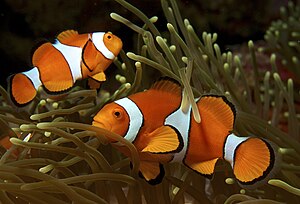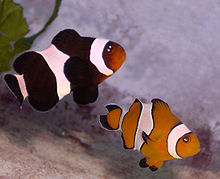Wrong clown fish
| Wrong clown fish | ||||||||||||
|---|---|---|---|---|---|---|---|---|---|---|---|---|

False clownfish ( Amphiprion ocellaris ) |
||||||||||||
| Systematics | ||||||||||||
|
||||||||||||
| Scientific name | ||||||||||||
| Amphiprion ocellaris | ||||||||||||
| ( Lacépède , 1802) | ||||||||||||
The false clownfish ( Amphiprion ocellaris ), also known as the orange ring anemonefish , lives west of the range of the real clownfish ( Amphiprion percula ) in the reefs of Southeast Asia , west to the Andaman and Nicobar Islands , north to the Ryukyu Islands and south to the coast of northwestern Australia . The distribution areas of the two clownfish species do not overlap.
features
The false clownfish grows to six to eight inches long. The length is 2.1 to 2.4 times the body height. The animals are bright orange in color with three white horizontal stripes, the middle one with a bulge facing forward. The dorsal fin has ten to eleven hard and 15 to 17 soft rays, the anal fin has two hard and 11 to 13 soft rays. The pectoral fins are supported by 16 to 18 fin rays. On the first gill arch there are 15 to 17 gill trap processes. The sideline is accompanied by 34 to 38 scales.
A melanistic color variant, which is purely black except for the transverse ligaments and the snout, lives near Darwin in Northern Australia and is considered the black form of Amphiprion ocellaris .
symbiosis

In the reef they live in symbiosis with sea anemones . These protect the clownfish from predators with their stinging tentacles. The clownfish also protect their symbiotic partners from predators, e.g. B. butterfly or filefish . They feed themselves on zooplankton - excretions can benefit the sea anemone. They protect themselves from the stinging cells of the anemone by a layer of mucus, which ensures that the stinging cells are not released. The slime is not produced by the fish, but is taken over by the anemone in a long process of “approaching”. The fish spawn in the immediate vicinity of their anemone, mostly on the foot. After hatching, the fish larvae are carried away by the current into the open water and are often transported far before the juvenile fish, lured by odor stimuli from the coastal region, approach a symbiotic partner again. The fish live in pairs or in harem groups with one female and several males in the anemone: the largest fish is always the female, the rest are males; if the female dies, the largest male changes sex and becomes female.
Amphiprion ocellaris lives in symbiosis with the magnificent anemone ( Heteractis magnifica ), the giant anemone ( Stichodactyla gigantea ) and Mertens anemone ( Stichodactyla mertensii ).
literature
- Gerald R. Allen : Damselfish of the World , Mergus Verlag Melle, 1991, ISBN 3-88244-007-4 .
- Daphne G. Fautin, Gerald R. Allen: Anemonefish and their hosts. Tetra-Verlag (1994), ISBN 3-89356-171-4 .
Web links
- Fake clownfish on Fishbase.org (English)
- "False clown fish" - keeping in saltwater aquariums
